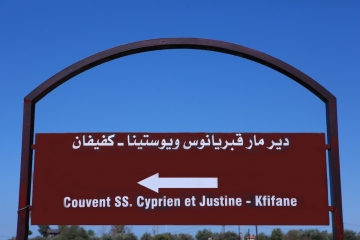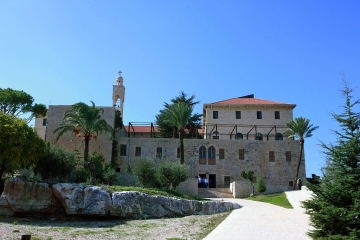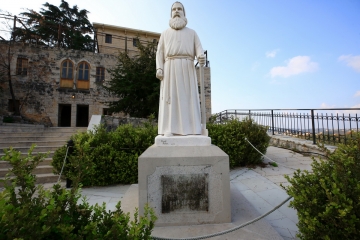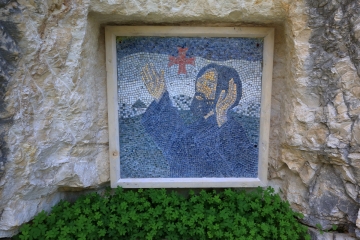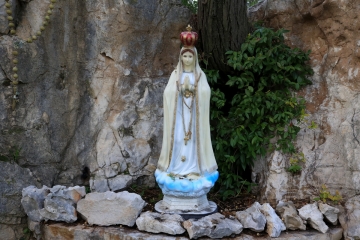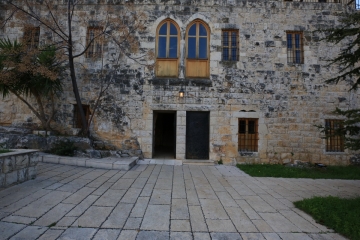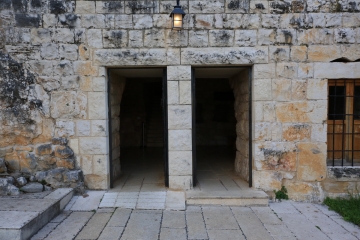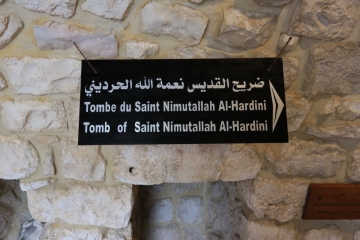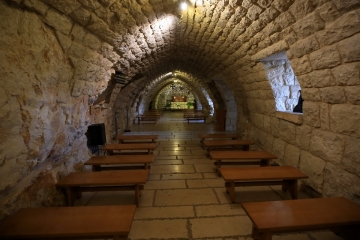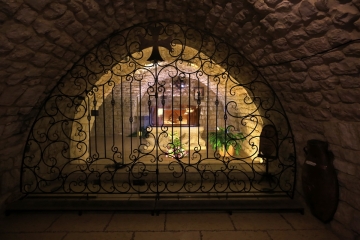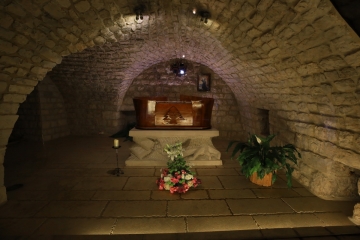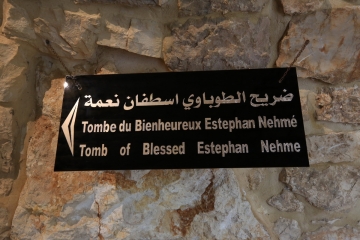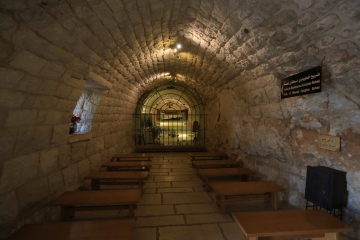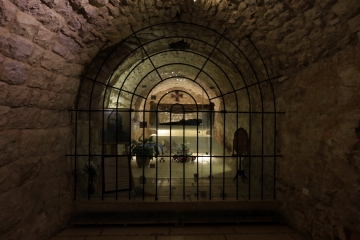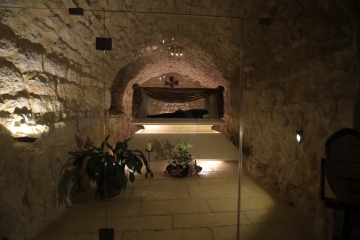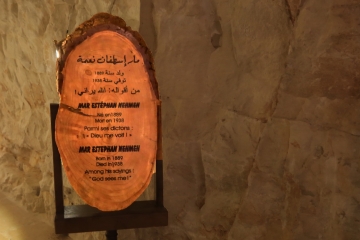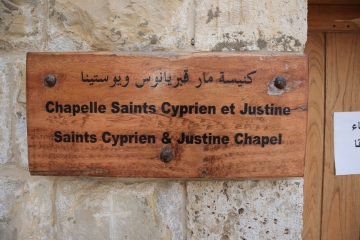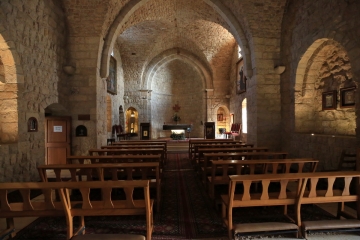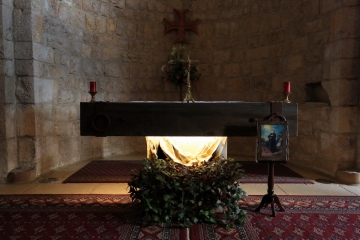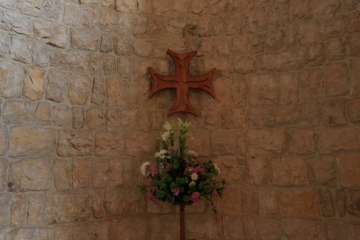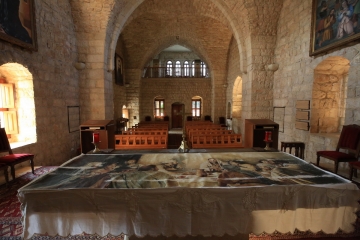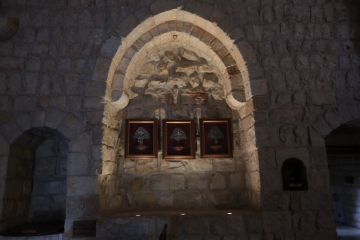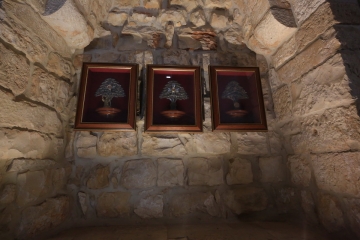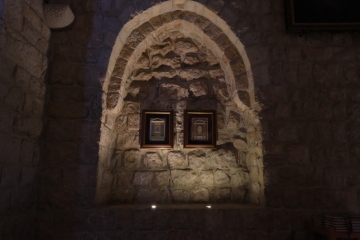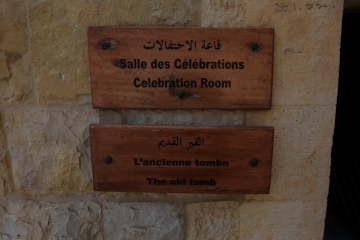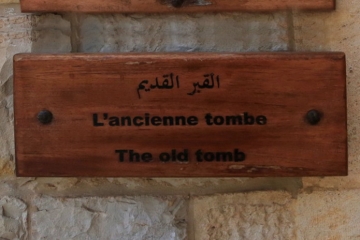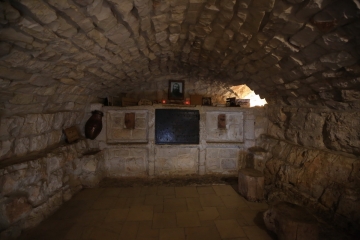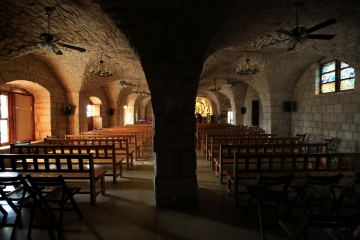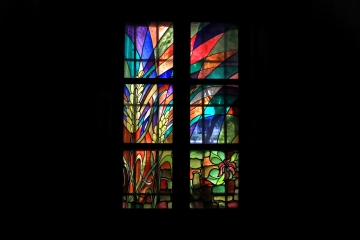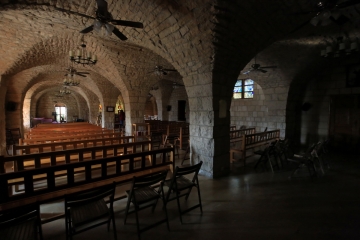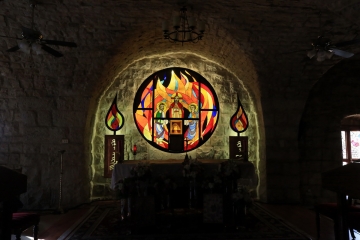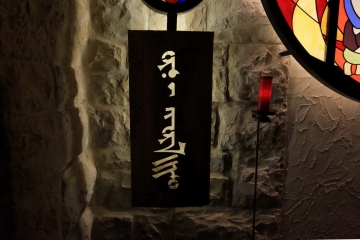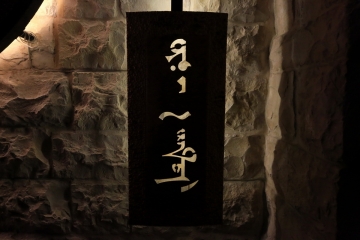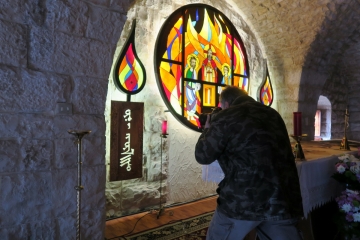دير مار قبريانوس – كفيفان
يعود تاريخ دير القدّيسَين قبريانوس ويوستينا إلى ما قبل القرن السابع للمسيح، ويقع في بلدة كفيفان في قضاء البترون على هَضَبة تعلو 450 متراً عن سطح البحر، تُحيط به قرى جران وعَبدللّي وسمار جبيل. ولفظة "كفيفان" هي، على ما يظهر، سِريانية أو كِلدانية، وتعود إلى تصحيف للفظة "كفيفو" التي تعني المُحدَّب والمُنحني نظراً لوجود القرية والدير على أرض مُحدَّبة بين واديَين أو شِعْبَين.
وقد تَكرَّس هذا الدير على اسم الشهيدَين قبريانوس ويوستينا عند تحويله إلى مَقرّ بطريركيّ في عَهد البطريرك دانيال الشاماتي أي في العام 1230، وهذا بِحسب ما ذكره البطريرك إسطفان الدويهي (1670-1704) في "سِلسِلة البطاركة الموارنة". وكانت هذه الانتقالة هي السادسة في سِلسِلة انتقالات المقرّ البطريركي المُتَعاقبة، وقد جَرَت من دير سيّدة يانوح "حيث كان جالساً على السدَّة البطريركية إرميا العمشيتي (1199-1230)" كما يقول الدويهي.
وهو يضمُّ جثمان القديس نعمة الله كسّاب الحرديني الذي دُعي "قديس كفيفان"، كما يَحضن جُثمان المُكرَّم الطوباوي اسطفان نعمة الذي توفّاه الله في الثلاثين من شهر آب 1938.
والوصف التاريخيّ لهذا الدير كما كان في حاله الأولى نَجِده في إحدى الوثائق العائدة له، وفيها أنه بناء صخريّ عقد، يبلغ طوله عشرين "ذراعاً هاشمياً" وعرضه خمسة "أذرع هاشمية"، مُقسَّم إلى "أربع غرف"، وهو يُعرَف منذ سنة 1779 بـ "كنيسة والدة الله مريم في كفيفان".
وقد تمَّ تجديد بنائه ما بين العامين 1865 و 1895، أي خلال مدةٍ إمتدت إلى ثلاثين سنة. وبعد سبعين سنةً من ذلك، أي في سنة 1965، شُرع بحملة ترميم للدير بكامله. وفي 1988 بدأ العمل لتشييد طابقٍ جديد لسكن الطلاّب المُبتدئين، كونه عُيِّن ديراً للابتداء منذ العام 1899، وهو باقٍ كذلك حتى الآن بعد سلسلة انتقالاتٍ منه وعودةٍ اليه.
وقد ألَّف عنه الأب بيار سعاده كتاباً بعنوان "دير الذهب: كفيفان" أورد فيه نبذةً كتبها الأب بطرس ساره يقول فيها: "إننا لم نَجِد قبل القرن الثالث عشر أثراً لتاريخ هذا الدير"، وقد عَقَّب عليها الأب سعاده بقوله: "كل ما جاء عن هذا الدير أنه كان كرسيّاً بطريركياً في مُستهلّ القرن الثالث عشر كما ذكر الدويهي في "سِلسِلة البطاركة"، موضحاً السبب في ذلك بـ: "أنَّ تاريخ تلك العصور لم يكن جلّياً واضحاً، او إن ما تركه لنا، ذَهَب، كغيره من الآثار، فريسة الضياع والدمار".
كذلك فإن الأب ساره يقول، تعليقاً على ما هو معروف من انتقال الكرسيّ البطريركيّ من يانوح إلى كفيفان في عهد البطريرك إرميا العمشيتي الذي دام من 1199 إلى 1230 : " نَظنّ أن عهد التاريخ بديرنا هذا أبعد من تلك الأيام، أي من أوآخر القرن الثاني عشر وأوائل الثالث عشر".
وكلام الدويهي ليسَ واضحاً حول ما إذا كان هذا الانتقال قد تمَّ في عهد البطريرك إرميا العمشيتي (1199-1230) أم في عهد خلفه البطريرك دانيال الشاماتي (1230-1239).. إذ يقول: " وانتقل الكرسيّ البطريركيّ سادسةً من سيّدة يانوح، حيث كان جالساً على السدَّة البطريركية إرميا العمشيتي سنة 1199-1230، إلى دير القديس إبريانوس في كفيفان حيث جلس دانيال الشاماتي خلفاً لإرميا".
وكتاب "بطاركة الموارنة .. إلى القرن الثاني عشر" للأب بطرس فهد وَرَد فيه أن لا ذكِر لسَكَن البطريرك إرميا في دير كفيفان، لكنه سكنه سنة 1209!!.
وكيفما كان الأمر فإنه لم يكن ثمة خلاف حول ان هذا الانتقال قد تمَّ من دير سيّدة يانوح إلى دير كفيفان.. إلى ان جاء الأباتي طوبيا العنيسي يقول إن دانيال الشاماتي انتُخب في دير سيّدة ميفوق، ثم ترك ميفوق وسكن في دير كفيفان. وزَكّى الأب فهد ذلك بقوله، في الصفحة 187 من كتابه: "قيل ان دانيال الشاماتي انتُخب بطركاً في سنة 1230 في دير سيّدة ميفوق، وبسبب الفِتَن والحروب، ترك ميفوق وسَكن في دير كفيفان"؛ فهل الانتقال كان من دير سيّدة يانوح إلى كفيفان أم من دير سيّدة إيليجإ ليها؟
ولكنَّ الدويهي، في الصفحة 12 من "سِلسِة البطاركة"، كانَ كلامه واضحاً تماماً بالنسبة إلى الموضع الذي جَرى منه الإنتقال إلى دير كفيفان، وإلى البطريرك الذي جرى في عهده هذا الانتقال والسنة التي حصل فيها، إذ قال: " في سنة 1230 انتقل إلى رحمة الله إرميا من عمشيت في دير سيّدة ميفوق، فَعَقَبه البطريرك دانيال من شامات من أعمال جبيل، فَسَكن أولاً في كفيفان"، وبذلك نقض ما قاله هو نفسه في "سلسلة البطاركة": "انتقل الكرسيّ البطريركيّ سادسةً من سيّدة يانوح ... إلى دير القدّيسَين قبريانوس ويوستينا في كفيفان".
وفي كتاب الأب سعاده ان تاريخ إنتقال البطريرك دانيال إلى كفيفان ورد في كتاب "التراتبية المارونية" ( La hiérarchie Maronite) للخورأسقف يوسف زياده على إنه نفس التاريخ الذي ذكره الدويهي.
أمّا الأب بولس مبارك، في كتابه: "عائلة الخوري تادي"، فيقول في الصفحة 259: "أول ما يُعرَف عن هذا الدير أنه كان كرسيّاً بطريركياً في مُستهلّ 1198"، أي في أوآخر القرن الثاني عشر، خلافاً لما قاله الأب ساره من أن تاريخ هذا الدير لم يوجد له أثر قبل القرن الثالث عشر.
ولكنَّ أجمل ما نَختُم به هذه اللَمحة عن دير كفيفان هو ما كتبه عنه الأب أنطوان خليفه عندما كان رئيساً له في العام 2000.. مُقدِّماً كتاب "دير الذهب : كفيفان"، فجاءت كلمته مُستوحاة من التاريخ العريق الذي لهذا الدير، وفَضلَه على الدراسة الإكليريكية للمبتدئين من أبناء الرهبانية اللبنانية المارونية، اذ قال: "منذ قيامه من ظُلمات الماضي السحيق ديراً على اسم الشهيدَين قبريانوس ويوستينا، مروراً بصيرورته، بعد يانوح (عدنا إلى ان الانتقال اليه كان من يانوح)، كُرسيّاً بطريركياً مارونياً مع البطريرك دانيال الشاماتي (إذن هو الذي انتقل إليه وليس سَلفِه إرميا العمشيتي) إثر وفاة البطريرك العَظيم إرميا العمشيتي، واللانطلاق منه بأول مدرسة عُليا لدراسة الفلسفة واللاهوت تجمعُ الإخوة الدارسين من أبناء رهبانيتنا اللبنانية المارونية، إلى إختياره، منذ مئة سنة وسنة، اي منذ 1899، ديراً موحَّداً للإبتداء بإرادة بطريرك كبير من هذه البقعة المباركة من أرض لبنان الخيرَّة.. المُثلَّث الرحمات البطريرك الياس الحويّك، حتى رُسوخه في الحاضر.. مُحتضناً ضريحَ الطوباويّ نعمة الله كسّاب الحرديني، قدّيس كفيفان، مُعلّم القديس شربل، ومحتضناً أيضاً ضريحَ الأخ إسطفان نعمه، وغيرهما من الوجوه الرهبانية التي تألَّقت روحانيةً وقداسة، كان كفيفان، الدير- المزار، يَنقُشُ صورَتَهُ على وجه التاريخ المارونيّ، وتاريخ لبنان، في هذه الأرض المقدَّسة، ويطبع بصماتِهِ في قلوبِ الكثيرينَ من أبناء الرهبانية".
بالعودة إلى القدّيسين، فقد وُلِد قبريانوس في مدينة أنطاكية من أسرة وثنية شريفة. وتخصّص منذ الصغر في عبادة الأصنام وفن السحر. وكان الشاب أغلاوس الوثني قد أُغرم بجمال فتاة تُدعى يوستينا. فأراد أن يتزوجها، لكنها رفضت وأجابت بأنها مخطوبة ليسوع المسيح. فلجأ الشاب إلى قبريانوس الساحر، فأخذ هذا يستعمل وسائل السحر، لكنه باء بالفشل. واعترف الشياطين بعجزهم. عندئذٍ قال قبريانوس: "إني لجاهل، فإن كانت ابنة مسيحية ضعيفة تنتصر على الأبالسة بمجرد الصلاة وعلامة الصليب، فماذا تكون إذن قدرة إله المسيحيين؟" فتاب قبريانوس واعتنق عبادة إله المسيحيين. واعتمد بعد أن تأثر بتعاليم الإنجيل السامية. وأحرق كتبه أمام الأسقف والشعب، ففرحت به يوستينا فرحاً عظيماً، وأخذت تصلي لثباته في إيمانه. وباعت حُليّها وأملاكها ووزعت ثمنها على الفقراء، واقتدى بها الشاب أغلاوس، فآمن واعتمد وعاش حياة صالحة. كما عاد الكثيرون من الخطأة إلى التوبة، ومن الوثنيين إلى الإيمان بالمسيح، كما ذكر قبريانوس في كتاب اعترافاته. لكن الملك ديوكلتيانوس، عندما جاء إلى نيقوميديا، أمر بتعذيبهما، فحفظهما الله من كل أذى. ثم أرسلهما إلى نيقوميديا عند ديوكلتيانوس وأخبره بما جرى، فأمر بقطع رأسيهما، فتكللا بالشهادة نحو سنة 304. ونُقلت ذخائرهما إلى روما ودُفنت في كنيسة القديس يوحنا اللاتراني.
Saint Cyprian and Justina Monastery – Kfifan
The monastery of Saints Cyprian and Justina dates back to before the seventh century. It is located in the town of Kfifan in the Batroun district, on a plateau 450 meters above sea level, surrounded by the villages of Jaran, Abdali, and Sammar Jbeil. The word "kfif" is apparently Syriac or Chaldean, and it refers to a correction of the word "kfifu", which means convex and curved due to the presence of the village and the monastery on convex land between two valleys or peoples
It was dedicated to the two martyrs, Cyprian and Justina, when it was converted into a patriarchal seat during the era of Patriarch Daniel Al-Shamaty, i.e. in the year 1230, and this is according to what Patriarch Estephan Doueihy (1670-1704) mentioned in “The Series of the Maronite Patriarchs.” This move was the sixth in a series of successive transfers of the patriarchal headquarters, and it took place from the monastery of Our Lady of Yanouh, "where Jeremiah Al-Amshiti (1199-1230) was sitting on the patriarchal seat” as Doueihy says
It houses the body of St. Nematallah Kassab Al-Hardini, who was called the "blind saint”, as well as the body of the venerable Brother Estephan Nehme, who passed away on the 30th of August 1938
We can find the historical description of this monastery in one of the documents belonging to it, in which it is mentioned that it is a rocky building with a length of twenty “Hashemite cubits” and width of five “Hashemite cubits”, divided into “four rooms”, and it has been known since 1779 as the “Church of Mary the Mother of God” in Kfifan
It was renovated over a period of thirty years, between 1865 and 1895. Seventy years later, in 1965, a campaign to restore the entire monastery was launched. In 1988, work began on the construction of a new floor for the accommodation of junior students, as it had been designated a monastery for beginners since 1899, and it has remained so until now, after a series of transfers from it and back to it
Father Pierre Saadeh wrote a book about it titled “Deir al-Dhahab: Blinds” in which he quoted a brief written by Father Boutros Sarah, in which he says: “We did not find a trace of the history of this monastery before the thirteenth century.” Father Saadeh commented on this by saying: “All that came up about this monastery is that it was a patriarchal seat at the beginning of the thirteenth century, as Al-Doueihy mentioned in the “Series of the Patriarchs,” explaining the reason for this by adding: “The history of this period was not clear, and whatever was left to us was destroyed with time
Likewise, Father Sarah says, commenting on what is known about the transfer of the patriarchal seat from Yanouh to Kfifan during the reign of Patriarch Jeremiah Al-Amshiti, which lasted from 1199 to 1230: “We think that the history of this monastery dates back to the end of the twelfth century and the beginning of the thirteenth
Al-Doueihy’s statement is not clear about whether this transition took place during the era of Patriarch Jeremiah Al-Amshiti (1199-1230) or during the era of his successor, Patriarch Daniel Al-Shamaty (1230-1239) as he says: “The patriarchal chair moved for the sixth time from Our Lady of Yanouh, where Jeremiah Al-Amshiti was sitting on the patriarchal seat between the years 1199 and 1230, to the monastery of St. Cyprian in Kfifan, where Daniel Al-Shamaty sat in succession to Jeremiah
And the book “The Maronite Patriarchs.. to the Twelfth Century” by Father Boutros Fahd states that there is no mention of Patriarch Jeremiah’s residence in the Kfifan monastery, but he did reside there in 1209
Whatever the case, there was no dispute that this transition took place from the monastery of Our Lady of Yanouh to the monastery of Kfifan, until Abbot Tobia al-Oneissi stated that Daniel al-Shamaty was elected in the monastery of Our Lady of Mayfouq, then left Mayfouq and lived in the monastery of Kfifan. Father Fahd agreed with him this by saying, on page 187 of his book: “It was said that Daniel Al-Shamaty was elected patriarch in 1230 in the monastery of Our Lady of Mayfouq, and because of the strife and wars, he left Mayfouq and lived in the Kfifan monastery.” Was the transfer from Yanouh to Kfifan, or was it from Mafouq to it
But Al-Doueihy was quite clear with regard to the place from which the move to the Kfifan monastery took place, and to the patriarch during whose reign this transfer took place and the year in which it occurred, when he said on the 12th page of his book: “In the year 1230 Patriarch Jeremiah of Amchit passed away in the monastery of Our Lady of Mayfouq, and Patriarch Daniel of Shamat in Byblos succeeded him, and was the first to reside in Kfifan,” thus contradicting what he himself said in “The Patriarchs Series”: “The patriarchal seat moved a sixth time from Our Lady of Yanouh to the monastery of the Saints Cyprian and Justina in Kfifan
The date of Patriarch Daniel’s move to Kfifan was mentioned in the book “La hiérarchie Maronite” by Archbishop Youssef Ziadeh as being the same date mentioned by Doueihy
As for Father Paul Mubarak, he writes in his book about the Khoury family: “The first thing that is known about this monastery is that it was a patriarchal see at the beginning of 1198,” that is, at the end of the twelfth century, contrary to what Father Sarah said about this monastery did not existing before the thirteenth century
But the most beautiful thing we conclude with this overview of the Kfifan Monastery is what Father Antoine Khalifa wrote about it when he was its president in 2000, in his book “Deir Al-Zahab: Kfifan”. His speech was inspired by the ancient history of this monastery. Being one of the members of the Lebanese Maronite Order, he said: “Since its rise from the darkness of the distant past, a monastery named after the two martyrs Cyprian and Justina, became a Maronite patriarchal chair with Patriarch Daniel al-Shamaty (meaning he is the one who moved to it, not his predecessor, Jeremiah Amshiti) following the death of the great Patriarch Jeremiah Amshiti, and the first high school for the study of philosophy and theology. This blessed spot of the benevolent land of Lebanon, embraces the tomb of Blessed Nematallah Kassab Al-Hardini, saint of Kfifan, teacher of St. Charbel, and also embraces the tomb of Brother Estephan Nehme, and other monastic figures that shone with their spirituality and holiness. The monastery of Kfifan is a that engraved its image on the face of Maronite history, and the history of Lebanon, in this holy land, and left its imprint in the hearts of many members of the monastery
Returning to the saints, Cyprian was born in the city of Antioch to a noble pagan family. From a young age, he was dedicated to idol worship and the art of magic. A pagan youth named Aglaias had fallen in love with a girl named Justina. He wanted to marry her, but she refused, saying that she was betrothed to Jesus Christ. The young man then turned to Cyprian, the magician, who began using magic to win her over, but he failed. The demons confessed their powerlessness. At that point, Cyprian said: "I am ignorant. If a weak Christian girl can defeat the demons simply by prayer and the sign of the cross, then what must be the power of the Christian God?" Cyprian repented and embraced the worship of the Christian God. He was baptized after being moved by the lofty teachings of the Gospel. He burned his books in front of the bishop and the people, and Justina rejoiced greatly, praying for his steadfastness in faith. She sold her jewelry and possessions, distributing the proceeds to the poor. The young Aglaias followed her example, believed, was baptized, and lived a righteous life. Many sinners returned to repentance, and many pagans converted to faith in Christ, as Cyprian mentioned in his book of confessions. However, when Emperor Diocletian came to Nicomedia, he ordered their torture, but God protected them from harm. They were then sent to Nicomedia, where Diocletian, after hearing what had happened, ordered their beheading. They were martyred around the year 304. Their relics were transferred to Rome and buried in the Church of St. John Lateran
